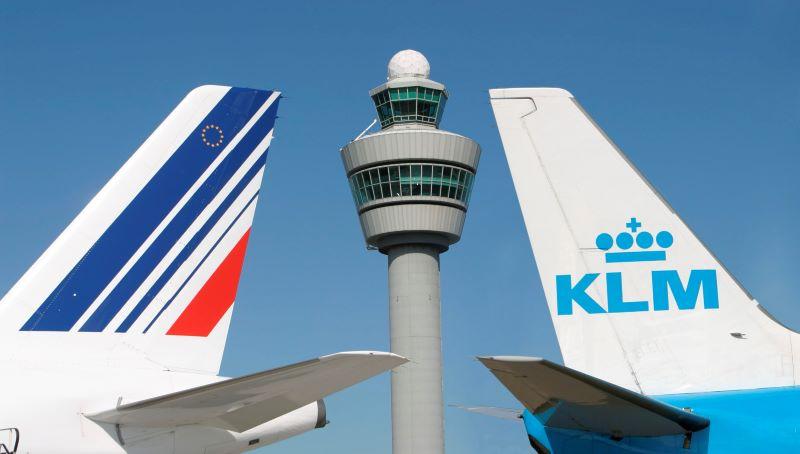
PARIS—Air France-KLM is targeting further profitability as it pushes ahead with its strategic plan, including fleet renewal and growth through alliances and M&A, executives said during a Dec. 14 investor day in Paris.
The Franco-Dutch airline group confirmed its existing outlook for 2024-2026 and set new targets for 2026-2028. It is aiming for a further profitability increase, with an operating margin above 8%; a further unit cost reduction, helped by the acceleration of its transformation program; continued improvement in cash generation, to deliver a significantly positive adjusted operating free cash-flow; and a continued optimization of the group financial profile, with long-term credit ratings at investment grade level.
“The transformation we have embarked on since 2019 at Air France-KLM has produced solid results, enabling us to rejoin the top tier of European leaders in the airline industry,” CEO Ben Smith said. Smith took over at the helm of the group in 2018 with the objective of transforming its strategy to improve profitability versus its European peers, but the pandemic threw that plan off course.
“We have delivered on our commitments, and I am particularly proud of the hard work carried out by all our teams to achieve these results, in a context marked by powerful headwinds,” Smith added. “We are now well-positioned to accelerate further and capture the full potential of our Group’s assets to deliver sustained and more profitable growth, while achieving the ambitious targets we have set ourselves for reducing our environmental impact.”
The group estimates net capital expenditure of €3.0-3.5 billion ($3.2-3.8 billion) per year between 2024 and 2026, and €3.5-3.8 billion per year in 2027 and 2028. Smith said the airline’s move to take a stake in Scandinavian Airlines (SAS), which it announced in October, is a “very low-cost, low-risk way of participating in M&A.”
“What we like is that immediately SAS will exit Star Alliance, which we think is a very very big win for Skyteam, and then in the near future we’ll look at does it make sense to bring SAS into the Air France-KLM, Virgin [Atlantic], Delta [Air Lines] joint venture,” Smith said. “Scandinavia already is a very strong point of sale market for KLM. [At] 19.9%, the ability to move SAS out of the Lufthansa group sphere; we’re quite happy with that.”
Air France-KLM previously said it would be interested in investing in TAP Air Portugal, which the Portuguese government wants to privatize. But the process could be a slow one with political upheaval in Portugal set to hold it up.
Angus Clarke, Air France-KLM’s chief commercial officer, highlighted the importance of codeshare partnerships and interline agreements for the group and the progress it is making on building on the many ones it already has in place.
The airline group has also recently renewed its partnership with Brazilian carrier Gol and has agreed to start commercial discussions with Colombian airline Avianca, despite its Star Alliance membership. “South America is looking interesting for us at the moment,” Clarke said.
Referring to its newly reinforced partnership with Etihad, Clarke said, “[It’s] in its early days but the signs are positive at this stage; we’re gradually expanding our codeshare, interline, and number of benefits around loyalty with Etihad.”
Smith told investors the group was confident of being able to maintain its entire long-haul network out of Schiphol, even if flight restrictions come into place there. The Dutch government has been trying to implement a flight capacity limit at Schiphol, which is KLM’s hub, to reduce noise, but for now, its plan is suspended.
Even if a limit does go ahead, “we’ve got quite a lot of flexibility to mitigate the loss of any slots,” Smith said. “We have full flexibility on our long-haul, medium-haul, and regional fleet by gauging up with the orders that we’ve made. So, we’re confident we can maintain our seat capacity. We have a lot of simulations around if we have to reduce one or two frequencies on some of the short-haul routes we will keep the entire long-haul network that we have. If we are put into a situation where you have to reduce some slots, then of course, we’ll upgauge.”
Discussing the airline group’s ongoing fleet rationalization plans, plans which Smith flagged as a priority when he took over as CEO in 2018, Clarke described the Airbus A350—of which Air France-KLM is set to have 99 eventually, subject to board approval—as “the dominant future of Air France-KLM ... the aircraft that is leading our economic recovery and is also essential our environmental trajectory.”
The group is building a simplified fleet for Air France around the A350 and the Boeing 777-300, with the Airbus A220 coming in to replace Airbus A318s and A319s. A decision on what will replace its A320s and Embraer aircraft will come at a later date, Clarke said.
At Air France’s Paris Charles de Gaulle (CDG) hub, the airline has been making progress on boosting the proportion of local traffic compared to connecting traffic, an objective it identified back in 2019, when the split was 50/50. “We’ve gone up by three points flipping it more toward local,” Smith said. “The Paris CDG hub is moving in exactly the direction we like. We see it getting to 54/55% local at CDG. That’s our aim for the time being.”
Air France recently announced it would be leaving Orly, Paris’s second airport, almost entirely by 2026, in a controversial move that has led to strikes among Air France employees.
